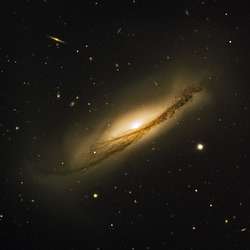
Spiral galaxy NGC 3190. Image credit: ESO. Click to enlarge
Supernovae are rare enough, but astronomers discovered two going off in galaxy NGC 3190 at the same time. NGC 3190 is a large spiral galaxy that we see nearly edge on. Its shape has been warped through interactions between other nearby galaxies, and it has an active galactic nucleus. Astronomers uncovered one supernova in the southeastern part in March 2002, and then another team uncovered a second supernova on the other side two months later. This photograph of NGC 3190 was taken by ESO’s Very Large Telescope.
his beautiful edge-on spiral galaxy with tightly wound arms and a warped shape that makes it resemble a gigantic potato crisp lies in the constellation Leo (‘the Lion’) and is approximately 70 million light years away. It is the dominant member of a small group of galaxies known as Hickson 44, named after the Canadian astronomer, Paul Hickson. In addition to NGC 3190, Hickson 44 consists of one elliptical and two spiral galaxies. These are, however, slightly out of the field of view and therefore not visible here.
In 1982, Hickson published a catalogue of over 400 galaxies found in compact, physically-related groups of typically 4 to 5 galaxies per group (see the image of Robert’s Quartet in ESO PR Photo 34/05 as another example). Such compact groups allow astronomers to study how galaxies dynamically affect each other, and help them test current ideas on how galaxies form. One idea is that compact groups of galaxies, such as Hickson 44, merge to form a giant elliptical galaxy, such as NGC 1316 (see ESO PR 17/00).
Indeed, signs of tidal interactions are visible in the twisted dust lane of NGC 3190. This distortion initially misled astronomers into assigning a separate name for the southwestern side, NGC 3189, although NGC 3190 is the favoured designation.
NGC 3190 has an ‘Active Galactic Nucleus’, and as such, the bright, compact nucleus is thought to host a supermassive black hole.
In March 2002, a new supernova (SN 2002bo) was found in between the ‘V’ of the dust lanes in the southeastern part of NGC 3190. It was discovered independently by the Brazilian and Japanese amateur astronomers, Paulo Cacella and Yoji Hirose. SN 2002bo was caught almost two weeks before reaching its maximum brightness, allowing astronomers to study its evolution. It has been the subject of intense monitoring by a world-wide network of telescopes. The conclusion was that SN 2002bo is a rather unusual Type Ia supernova. The image presented here was taken in March 2003, i.e. about a year after the maximum of the supernova which is 50 times fainter on the image than a year before.
While observing SN 2002bo in May 2002, a group of Italian astronomers discovered another supernova, SN 2002cv, on the other side of NGC 3190. Two supernovae of this type appearing nearly simultaneously in the same galaxy is a rare event, as normally astronomers expect only one such event per century in a galaxy. SN 2002cv was best visible at infrared wavelengths as it was superimposed on the dust lane of NGC 3190, and therefore hidden by a large quantity of dust. In fact, this supernova holds the record for the most obscured Type Ia event.
The image was obtained with a total exposure time of 14 minutes only. Yet, with the amazing power of the Very Large Telescope, it reveals a large zoo of galaxies of varying morphologies. How many can you find?
Original Source: ESO News Release
